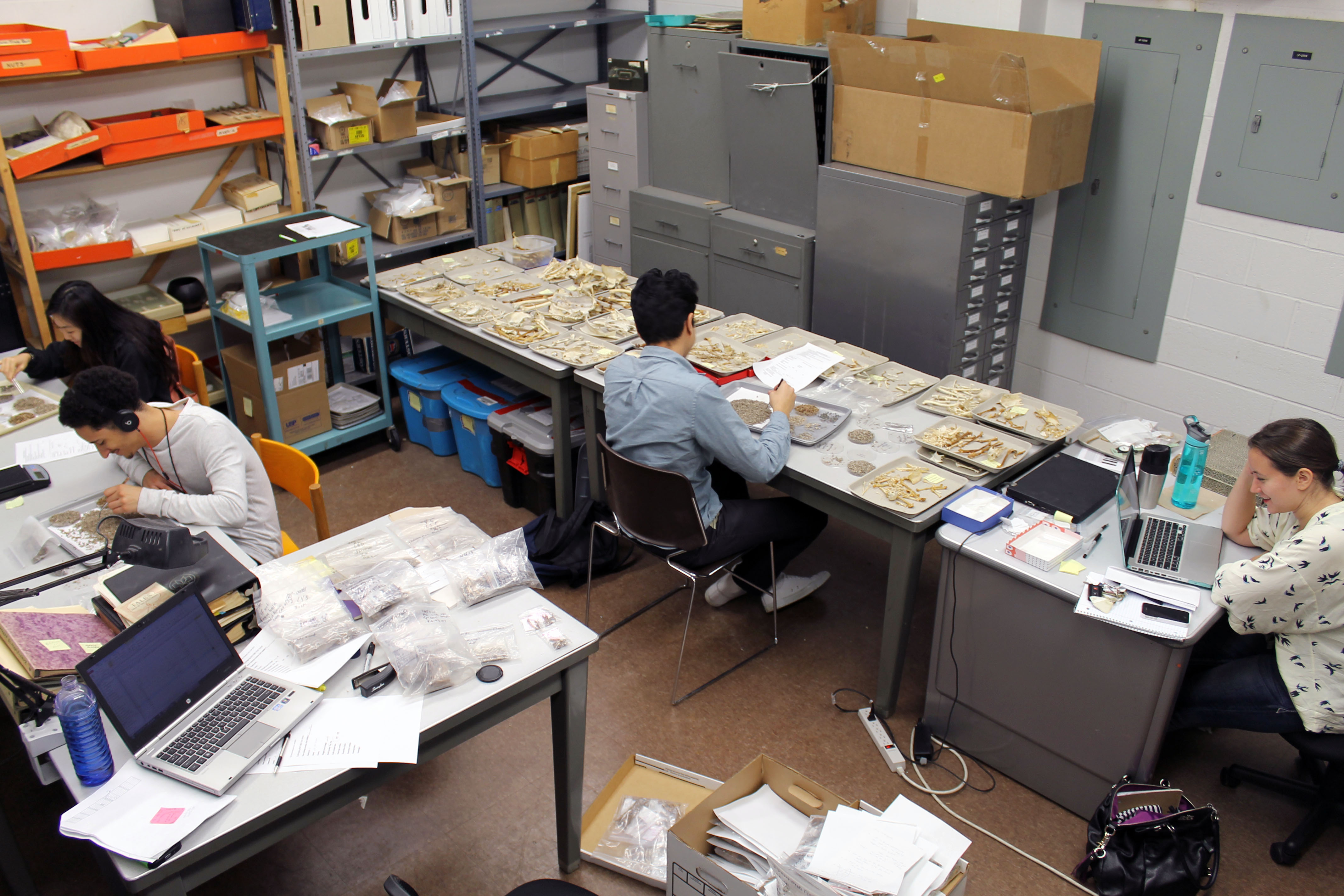
At work in the lab…


Author: Ariel Taivalkoski
While it has become more common to identify the bird bones from archaeological sites to family, it is rare to have a bird bone assemblage as large as that from the Rat Islands Project site KIS-050 test excavation. The midden context of this Kiska Island site has preserved the bird bones in excellent condition. We have over 5,000 bird bones, many of which are whole. It was initially daunting to organize the data collection for this assemblage and our analysis spreadsheet went through several iterations before I was able to create a database that allowed us to collect the most useful information while still allowing us to finish the analysis of this collection within a timely manner.
During one of the revisions of our spreadsheet, I decided that I would need to begin measuring our bones, following standards in Gilbert (1996) and Driesch (1976) that aid in species identification. My primary goal for recording these measurements was to help us quickly differentiate between the large numbers of Alcids, which range greatly in size, that were present at the site. Additionally, this will help us to conduct our overall species identifications in a timelier manner.
This revision came after I analyzed 15 level assemblages to family. Dr. Funk and I have spent a couple days recently revisiting the identified elements to record these standard measurements. This process has allowed us to expand our data set, as well as served to double-check my family level identifications for the first identfications I made.
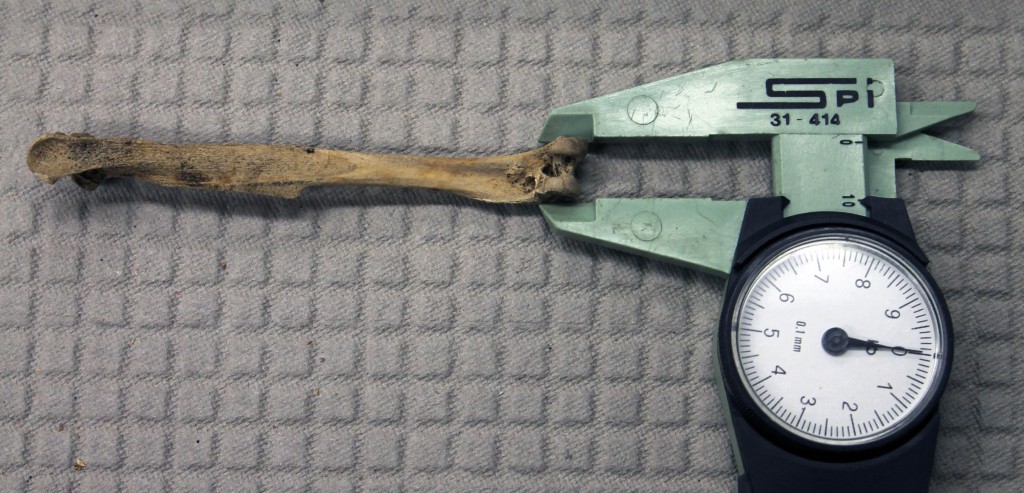
Author: C. Funk | Rats Project Lab at UB | July 9, 2015
Thanks to the efforts of twenty or more undergraduate students, graduate students, and researchers at UB and Hamline University our ¼ inch screen bulk samples from the KIS-050 village midden are sorted to component parts. Samples of identified fish, bird, and mammal elements are in the isotope lab at UAF. Mammal bone elements are being identified by the Hamline team, birds by the UB team. Stone tools go to Hamline, bone tools stay here at UB.
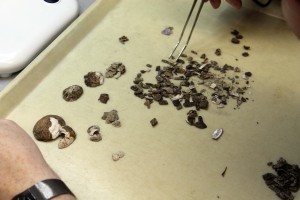
This month the invertebrates from the bulk samples will receive our focused attention. Josh Howard, a graduate student working in the Rats Lab at UB this summer and I are sorting, counting, weighing, and starting to identify the invertebrate assemblage from the ¼ inch bulk sample fraction. We measure whole lantern pyramids (mouth parts) from Strongylocentrous spp. (sea urchins) to track their size over time. Smaller urchins may indicate periods of heavy harvesting and signal community shifts in the local intertidal zone. Limpet size shifts may similarly signal ecological changes, but most of the limpets are fractured and impossible to measure – their little hat tops, the apex portions, are separated from their wide brims.
Periwinkles and other gastropods, mussels, and chitons live in the modern rocky intertidal zone near the archaeological site, but they are poorly represented in the archaeological assemblages. We count the hinge fragments of mussels and the whorls of gastropods to learn how many are present in a sample. The numbers are variable, but low for each bulk sample – less even than one serving of bouillabaisse or Portuguese caldeirada de peixe might have in it. We’d be happy to count chiton plates, if only they were present in the prehistoric occupation debris of KIS-050. We thought they should be present, since our team ecologist saw so many in the modern intertidal zone.
Archaeologists in the Aleutian Islands tend to think of prehistoric sites and reefs as paired – reefs can be rich resource areas. But as our work continues to demonstrate, prehistoric Aleut use of these resources was complex. The details of which invertebrates were harvested, where they were eaten, and how people disposed of them remain obscure to us. Measuring invertebrate abundance, size, and community parameters will tell us more about the circumstances of Aleut choice – what species were even available to eat in the dynamic intertidal environment?
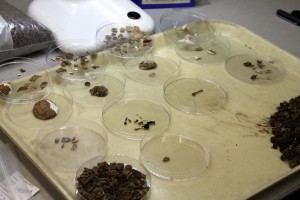
Author: C. Funk | UB Rats Project Lab | May 29
Our bins of unsorted midden and unanalyzed bird bones are emptier every day as we work through our sorting and analyses. Darren Poltorak just spent three months sorting 1/4″ screen bulk samples – we sent the fish he sorted to Megan Partlow of Central Washington University for analysis. Her data will be posted on our results page soon.

I’m weighing, counting, and measuring the shellfish from the bulks Darren sorted. Soon Josh Howard will be sorting the 1/8″ screen bulk samples. He’ll be measuring many sea urchin mouth elements so that we can look for changes in sea urchin body size over the more than 2,000 years people harvested them from the Corvie Bay intertidal zone. Ariel Taivalkoski and I are working to identify our more than 5,000 bird bones. So far she (with a little help from me!) has identified 1,700 bones to avian family. We are seeing interesting shifts in the types of birds present over time and in differentl behavioral contexts.
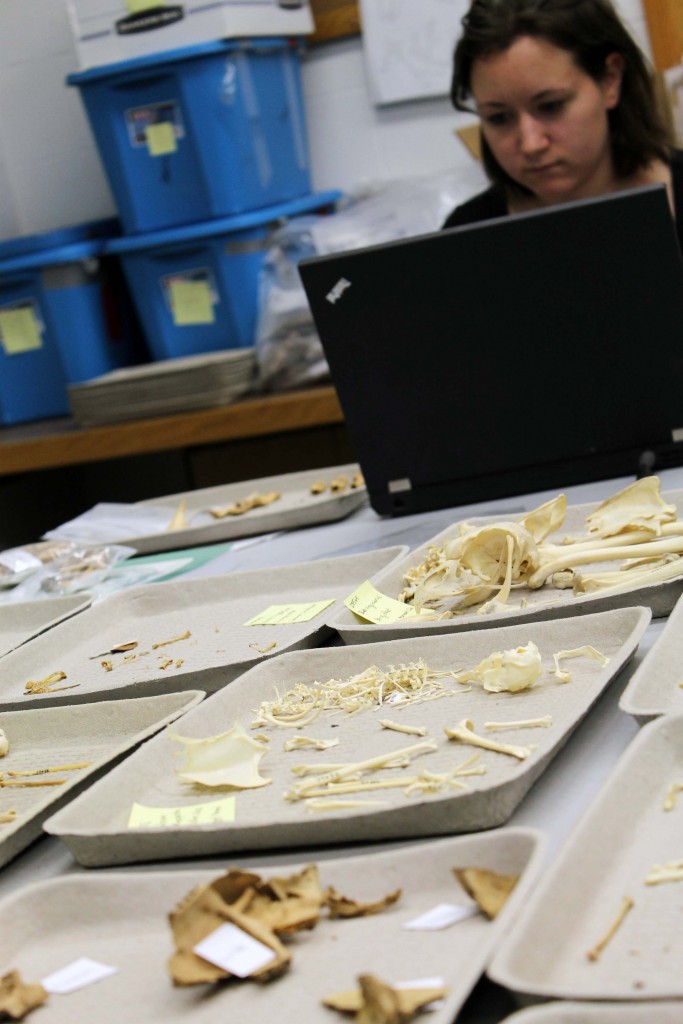
Author: C. Funk | University at Buffalo | October 9, 2014
We’re working here in the Rat Islands research lab at University at Buffalo. It’s a Thursday afternoon – outside it’s windy and sunny, a perfect fall day. In here the lights are shining brightly on Ariel, Bobbi, and me. Bobbi is cataloging bone tools and I’ll talk to her about that a bit next week.
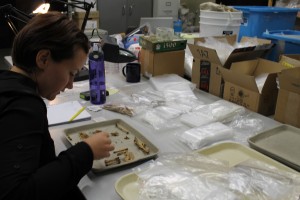 Today I’m interested in what Ariel is doing.
Today I’m interested in what Ariel is doing.
Ariel is a second year graduate student here in the department. She is planning to specialize in monumentality and colonialism in Europe for her dissertation research. She happens to have a skill set in bird osteology and that’s why she’s here with us.
“What are you doing over there?” I ask her. She rolls her eyes at me a little bit because I can clearly see what she is doing, “sorting a sample bag of bird bones into elements,” she says. After a moment she says, “I think this is just one bird, part of the thoracic area and the wings. The vertebrae are articulating and the tarsometatarsi are paired.” We do a quick check in the bird book and it seems to be a small cormorant. Our comparative osteological collection will arrive from the Burke Museum in Seattle next week. We’ll identify the bird then.
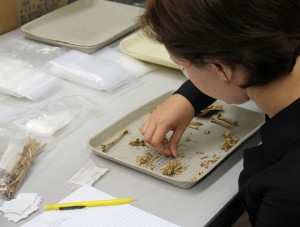 Bobbi and Ariel and I are talking about excavation sampling strategies and their impacts on which elements were collected and on the patterns of bone presence we’ll use to talk about Aleut resource exploitation, processing, and discard strategies. Ariel says that she thinks she is seeing more humerii and ulnae in general – those are the bones in the bird wing. But some samples have a higher concentration of leg elements. “Mostly,” Ariel looks up at me from her study of the bones on the table, “mostly we seem to have more wings than butts.” Bobbi looks interested at this. “Maybe they were making a lot of bird butt hats. In the field, Debbie said Aleuts made duck butt hats for babies. They cut the legs off and sewed the thighs so the feathered legs stuck up like feathery little ears.” We talk about wearing bird butt hats for a bit before we settle back into work.
Bobbi and Ariel and I are talking about excavation sampling strategies and their impacts on which elements were collected and on the patterns of bone presence we’ll use to talk about Aleut resource exploitation, processing, and discard strategies. Ariel says that she thinks she is seeing more humerii and ulnae in general – those are the bones in the bird wing. But some samples have a higher concentration of leg elements. “Mostly,” Ariel looks up at me from her study of the bones on the table, “mostly we seem to have more wings than butts.” Bobbi looks interested at this. “Maybe they were making a lot of bird butt hats. In the field, Debbie said Aleuts made duck butt hats for babies. They cut the legs off and sewed the thighs so the feathered legs stuck up like feathery little ears.” We talk about wearing bird butt hats for a bit before we settle back into work.
I ask Ariel if she has worked with birds at other sites. She has. She worked on the Pompeii Archaeological Research Project: Porta Stabia. But she worked with flotation samples there, so the specimens were small and fragmented. She says that the Rats materials are larger, that there are more whole elements, and that the preservation of this collection is excellent.
“Why birds?” I ask Ariel. “Because another researcher asked me what I’d like to look at. I picked birds because I don’t want to do fish and it turns out birds aren’t studied often. People think they are difficult but they are actually easy to identify to family. There’s a lot of room for research.”
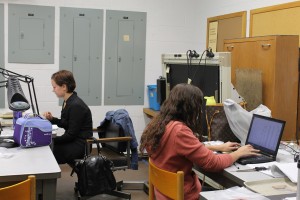 I’ve stopped bothering Bobbi and Ariel and they are working away. I can hear the bones shuffling around on the table in front of Ariel, and the keyboard clattering while Bobbi enters artifact catalog data on the lab computer.
I’ve stopped bothering Bobbi and Ariel and they are working away. I can hear the bones shuffling around on the table in front of Ariel, and the keyboard clattering while Bobbi enters artifact catalog data on the lab computer.